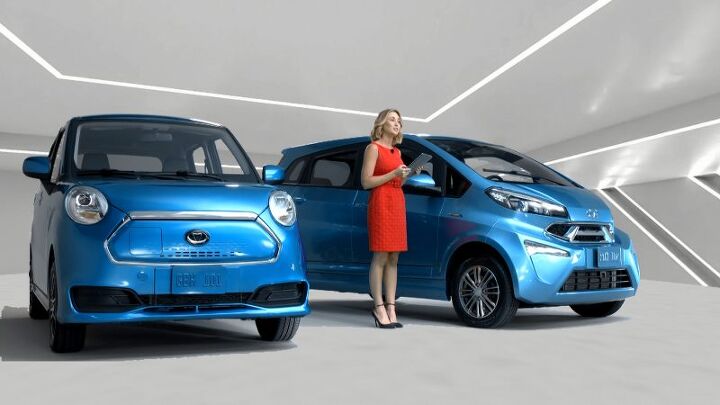What Goes Up: U.S. Arm of Bargain-basement Chinese EV Maker Fails to Impress Wall Street

Interested in a new electric vehicle with an after-tax credit price of $9,999? What about a larger model stickering for $19,999? Hmmm… doesn’t seem to be that many of you.
You can be forgiven for not knowing about Kandi America, the U.S. subsidiary of Kandi Technologies Group — a Chinese battery and electric vehicle manufacturer. Earlier this week, Kandi revealed two models it plans to bring to America in the hopes of cleaning up at the low end of the EV market. Having seen its share price skyrocket after announcing a U.S. market entry last month, the company’s stock fell back to earth when Wall Street gauged the public’s enthusiasm.
Nearly 11,000 “potential buyers” registered for the online reveal of the K27 and K23 on Tuesday, Kandi America stated, with one of those attendees winning a free K23. A small, four-door hatchback with a 41 kWh battery, the K23 is said to possess a range of 188 miles, with its electric motor generating a paltry 28.2 horsepower. How much torque it makes, we don’t know.
Top speed is pegged at 70 mph, meaning the vehicle would be capable of travelling on American highways.
The K27 is a retro-themed four-door hatch with slab sides and “ain’t I cute?” round headlamps that bring to mind those of the Mini Cooper. The cheaper of the two models, a K27 delivers 26.8 hp and a top speed of 63 mph. Range is said to be 100 miles.
Hoping to tickle buying bones across America, Kandi offered a promotion to the first 1,000 reservation holders. “Originally priced at $19,999 MSRP, the K27 is now listed as $17,499,” the company stated. “The K23 is discounted from $29,999 MSRP to $27,499. With the $7,500 federal tax credit, this brings the prices down to just $9,999 and $19,999 respectively for eligible buyers.”
After its late-July announcement, Kandi saw its Nasdaq-listed stock rise 140 percent the following day. Wall Street loves EV promises, don’t you know. However, when Kandi announced that the first 24 hours after the launch saw the company collect 436 pre-order reservations — fully refundable $100 ones, at that — the balloon burst.
On Wednesday, The Motley Fool wrote, “Yesterday, shares of Kandi stock fell 13.5% in the aftermath of the presentation. Today, they’re down nearly 9% more.”
The stock fell through the remainder of the week, and is down 5.5 percent since trading commenced today. Since Tuesday morning, the company’s share price, which spent the better part of this year trading in the $3-$4 range, has fallen from $10.60 a share to $7.07 at last check.
Regardless of the reveal’s shortcomings, the Texas-headquartered Kandi America says it wants to start building product in the United States.
In a release, the company said “it plans to more aggressively target the fast-growing North America market and ensure affordability by eliminating shipping costs and tariffs,” adding that “The Company is in preliminary discussion with various potential partners, including local government agencies from the US-Mexico border, and has received positive feedback.”
It did offer a disclaimer, though: “The Company cautioned that the exploration process is in its early stage and any negotiations would not guarantee a North American plant will be built.”
This is when we place our bets. Where does yours lie?
[Image: Kandi America]

More by Steph Willems
Latest Car Reviews
Read moreLatest Product Reviews
Read moreRecent Comments
- Dwford Will we ever actually have autonomous vehicles? Right now we have limited consumer grade systems that require constant human attention, or we have commercial grade systems that still rely on remote operators and teams of chase vehicles. Aside from Tesla's FSD, all these systems work only in certain cities or highway routes. A common problem still remains: the system's ability to see and react correctly to obstacles. Until that is solved, count me out. Yes, I could also react incorrectly, but at least the is me taking my fate into my own hands, instead of me screaming in terror as the autonomous vehicles rams me into a parked semi
- Sayahh I do not know how my car will respond to the trolley problem, but I will be held liable whatever it chooses to do or not do. When technology has reached Star Trek's Data's level of intelligence, I will trust it, so long as it has a moral/ethic/empathy chip/subroutine; I would not trust his brother Lore driving/controlling my car. Until then, I will drive it myself until I no longer can, at which time I will call a friend, a cab or a ride-share service.
- Daniel J Cx-5 lol. It's why we have one. I love hybrids but the engine in the RAV4 is just loud and obnoxious when it fires up.
- Oberkanone CX-5 diesel.
- Oberkanone Autonomous cars are afraid of us.


































Comments
Join the conversation
Absolute crap cans. The K27 looks like an electric Trabant (intentional?). If you want cheap and electric, buy a used Fiat 500e, or a used first-gen Smart Fortwo Electric Drive.
Ugh, electric Yugo. Can't unsee it now.